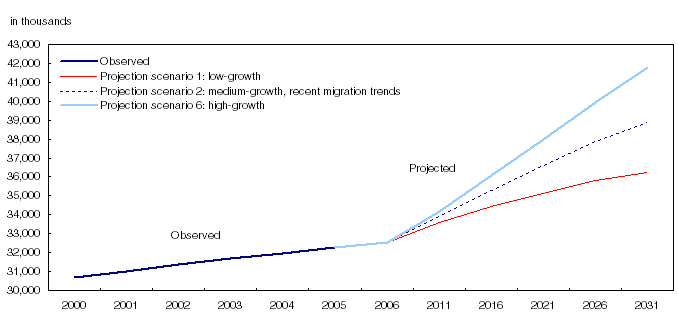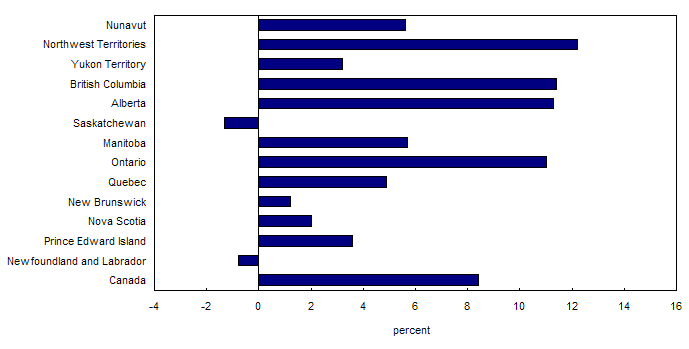Common menu bar links
2006
Archived Content
Information identified as archived is provided for reference, research or recordkeeping purposes. It is not subject to the Government of Canada Web Standards and has not been altered or updated since it was archived. Please "contact us" to request a format other than those available.
Section 10: Projections
Long-term population projections
Statistics Canada estimates six sets of population growth scenarios for Canada, the provinces and the territories which take into account the current demographic trends in all components of population growth. It should be emphasized that these projections are not predictions. Rather, they represent an attempt to establish plausible long-term scenarios based on assumptions of fertility, migration and mortality, which are subject to varying degrees of uncertainty. As such, they are valuable statistical information for planners, policy makers, and the public at large interested in the future course of demographic change and related issues.
A components method was used by Statistics Canada. For each component of population growth, one or more assumptions were made regarding how that component would evolve in the future. These assumptions, when combined, form a number of projection scenarios. In all, there are three assumptions each on fertility, mortality and immigration and four assumptions on interprovincial migration; in combination, these assumptions generate 108 scenarios on the future course of population change. Some of the results of projection 1: low-growth, projection 2: medium-growth which includes recent migration trends, projection 3: medium-growth which includes medium migration trends, and projection 6: high-growth, are shown in tables 10.1 to 10.2-4 . For a more in-depth analysis of each growth scenario’s inputs, please consult Population Projections for Canada, Provinces and Territories, catalogue no. 91-520-X.
As indicated by selected projection scenarios, Canada’s population should continue to grow between now and 2031 (chart 10.1 ). According to the low-growth scenario, Canada’s population will increase from 32.5 million in 2006 to about 36.3 million in 2031, an increase of 11.5%. The high-growth scenario’s assumptions of higher fertility, higher immigration and higher life expectancy boost the Canadian population to 41.8 million in 2031. This is 28% more than the population in 2006.
Short-term population projections
Using projection 3, a medium-growth scenario, short-term projections of population show an increase from 2006 to 2016 in each province and territory except for Newfoundland and Labrador (-0.8%) and Saskatchewan (-1.3%) (chart 10.2 ). Above the Canadian average of 8.4% growth are the Northwest Territories (12%), British Columbia (11.4%), Alberta (11.3%) and Ontario (11%).
Results may differ depending on which scenario is used due to the cumulative effects of fertility, immigration and interprovincial migration, which varies widely from province to province.
Canada’s ageing population
Canada's population is ageing fast and senior citizens would outnumber children in about a decade, according to the latest population projections (tables 10.1 to 10.2-4 ).
In all six Statistics Canada growth scenarios, seniors aged 65 and over would become more numerous than children aged less than 15 around the year 2015. This would be an unprecedented situation in Canada.
By 2031, the number of people aged 65 and over would range between 8.9 million and 9.4 million, depending on the scenario selected, while the number of children would range between 4.8 million and 6.6 million.
The aging of the baby boomers combined with continuing low fertility levels and increasing longevity will age the population rapidly. The arrival of baby boomers at age 65 also has implications for the work force during the coming decades.
Population ageing will accelerate as baby boomers reach 65
Like the decline in natural increase, the ageing of the Canadian population is inevitable, since it is largely already inherent in the age structure of the current population.
The projections show that population ageing, which has already begun, would accelerate in 2011 when the first baby-boom cohort (persons born in 1946) reaches the age of 65. This rapid ageing is projected to last until 2031, when seniors would account for between 23% and 25% of the total population. This would be almost double their current proportion of 13%.




